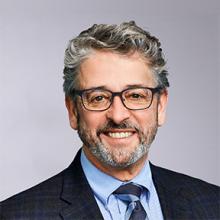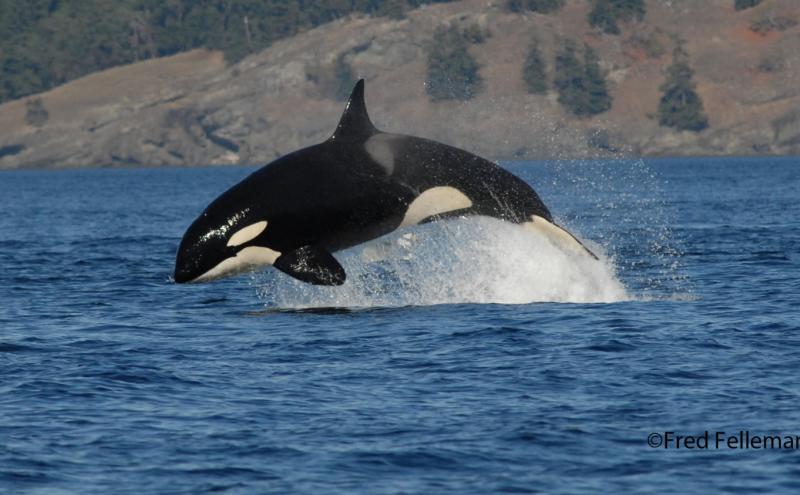
It takes approximately a month from the time an order is placed in China before it arrives in Washington. That makes seaport activities a far better barometer of the economy’s health than the daily fluctuations of the stock market.
While the haphazard inflictions of tariffs on our trading partners have led to more uncertainty for port-related businesses than usual, we’re reorienting our forecast strategy to react to shorter-range weekly data. But we already know we’re in for some rough waters.
Despite this week’s reductions in tariffs on Chinese goods, we have already been made aware of three blank sailings this week. One missed sailing is rare enough. And in recent weeks, we’ve seen less cargo loaded onto ships that do call. This puts high-wage jobs in danger for longshore workers and truck drivers who are only paid per container they move. This has ripple effects throughout the supply chain resulting in scarcity, higher cost and if it persists — recession. And the resumption of normal cargo handling operations cannot occur overnight. In fact, these abrupt changes can result in permanent alternatives that will particularly impact our agricultural exporters.
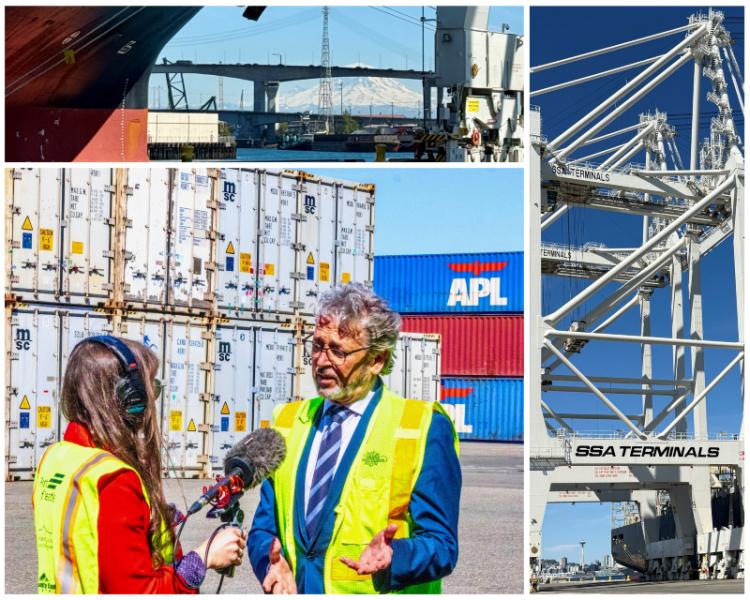
Speaking with KUOW’s Monica Nickelsburg on Terminal 5 about the impacts of tariffs on trade and the Port of Seattle’s business lines
Washington is the most trade-dependent state in the country, making this an especially perilous moment for our state’s economy and working families. I’ve done a number of interviews and events on this subject in the past few weeks, including speaking with KUOWs Monica Nickelsburg and Eddie Rye for his Urban Forum NW show on KKNW. I also joined Commissioner Sam Cho and Senator Maria Cantwell for a press event to publicize the damage tariffs do to Washington’s small businesses. The President’s latest attempt to reset tariffs with China to 30% for imports may limit some damage, but the uncertainty in U.S. reliability will persist. Even after the reset, tariffs with China, our largest trading partner, remain at historically high levels. As we continue to navigate ongoing trade disputes, the Northwest Seaport Alliance will provide weekly updates on the website. And I’ll provide regular updates of how tariffs impact the Port’s business lines on my LinkedIn and Facebook pages.
Tourism — Indigenous leadership can help mend fences with Canada
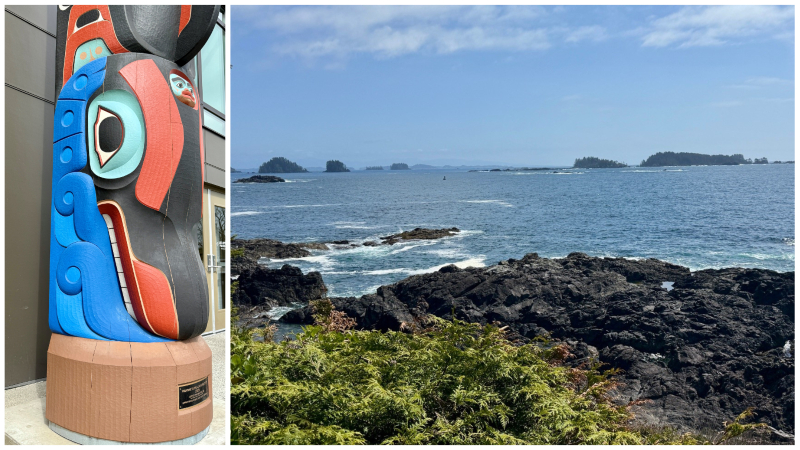
Left: A Jamestown S’Klallam totem pole depicting an orca eating an octopus; Right: Looking out on the Pacific Ocean from the shores of Ucluelet, B.C. during the Indigenous Tourism Conference
Tourism in Washington is big business. And, just like maritime cargo, it’s being impacted by tariffs and repeated challenges to Canadian sovereignty. According to the U.S. Travel Association, “travel is one of America’s most powerful economic engines — supporting 15 million jobs, generating $2.9 trillion in economic output, and funding essential public services.” And Canadians are our number-one visitors.
That’s why I was surprised to hear a U.S. border agent say, “Haven’t you heard, man — tourism is dead” as I returned to Washington earlier this month from an enlightening conference on Indigenous tourism in Ucluelet, B.C. The focus of the conference was on the ways Indigenous communities can thrive in the tourism industry.
If that customs agent had attended the conference, he might have thought differently. From what I saw, tourism is alive and growing, thanks to Indigenous leadership.
While the U.S. and Canada find ways to collaborate, tribes on both sides of the border will continue to host visitors and celebrate their connections through their annual canoe journey — an event that will be hosted by the Elwha Tribe in Port Angeles this year.
My recent trip to Ucluelet also builds on the work I am supporting with the Snoqualmie Tribe, local businesses, the Snoqualmie Chamber of Commerce, the Port’s tourism development team, and State of Washington Tourism. We’re working together to create a stewardship model that promotes responsible tourism and sustainable economic development. Our goals are modeled in part on the Snoqualmie Tribe’s Ancestral Lands Movement.
Read more about the Port’s efforts to welcome visitors from around the globe and promote responsible tourism in Washington:
- Tourism — Another Export Casualty of Cross-Border Disputes
- Tourism in Washington — Verdant and Vibrant
- What Is Responsible Travel?
- Download the Responsible Travel Handbook (PDF)
The Port’s 2024 Environment and Sustainability Report
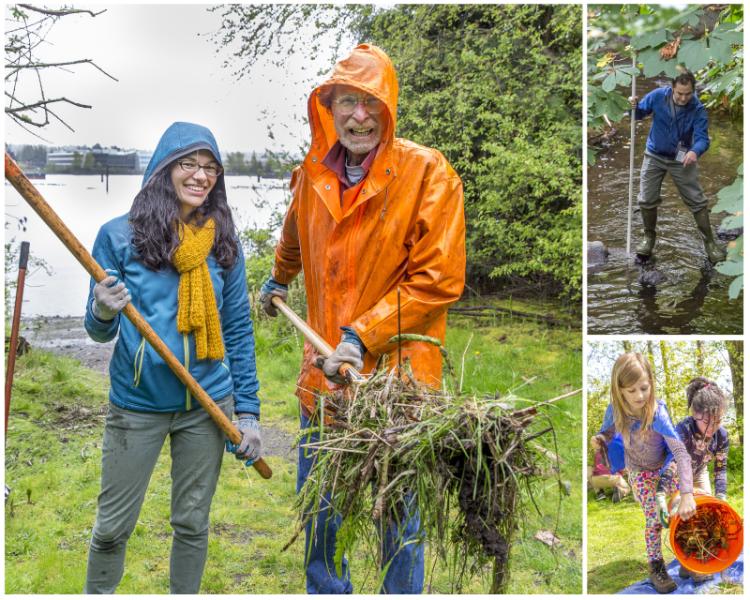
Volunteers and members of the Port of Seattle’s environment team work to restore habitat along the Duwamish River
With more businesses looking to meet their own pollution reduction goals, the Port of Seattle’s commitment to sustainability has become a competitive advantage in trade and travel. For example, all three of our cruise ship terminals now have shore power, a significant accomplishment that resulted in the reduction of nearly 4,000 tons of carbon emissions last year.
Another significant accomplishment of our environmental programs is that eight construction projects are now targeting environmental certification, and ten of our projects have been subject to our sustainable evaluation framework. And our new electrification and energy transition plan, released on Earth Day, will help ensure the Port’s power needs can be met with 100% clean electricity by 2050.
This isn’t just about the environment — it also reduces our impacts on near-port communities, helping make the Port of Seattle a better neighbor.
- Download the full report (PDF)
Ports of the Future Conference — Houston
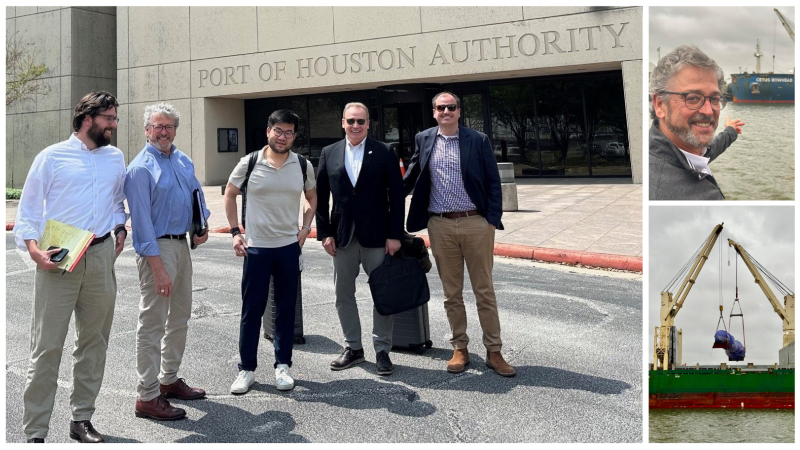
Port of Seattle attendees at the Ports of the Future Conference in Houston Texas — clockwise from left: Attending a meeting at the Port of Houston with Port Commission Strategic Advisor Jim Mumford, Commissioner Sam Cho, Executive Director Steve Metruck and Alex Adams, senior manager for environmental programs; Pointing to the vessel Cetus Bowhead and bulk cargo being loaded on a freighter during tour of Houston ship canal
In an effort to build on our clean energy transition playbook, I traveled to Texas earlier this month with a team that included Commissioner Sam Cho and Steve Metruck, the Port’s executive director, as well as his chief of staff, Kathy Roeder, and other staffers across multiple teams. We attended the “Ports of the Future” conference, hosted by the Port of Houston. Before the conference began, our team held a series of meetings with executives at the Port of Houston and alternative fuel providers.
Thanks to their insights, we learned more about what it will take for the Port of Seattle to provide clean, low-carbon fuels to our partners and customers. The Port of Houston was able to share details on innovative projects private terminal owners are pursuing in their region to leverage existing infrastructure for lower-carbon fuel production and transport. During the conversation we discussed market incentives and major players who are investing at large scale, such as Maersk, Woodside, and the Summit Agricultural Group.
We also met with members of the HyVelocity Hub, the regional clean hydrogen hub based along the Gulf Coast. Representatives from Air Liquide, Orsted, and Chevron asked us about our goals and challenges and emphasized the message that fuel companies need an anchor tenant to justify major investments. That drove further discussion regarding opportunities to get our regional hydrogen hub here in Washington engaged with a current project to study demand cycles between I-10 in Texas and I-5.
We spent the next two days listening to presentations on the University of Houston’s campus, focused on innovation in the maritime industry. Topics under discussion ranged from environmental sustainability to cybersecurity and infrastructure resilience. Our executive director gave one of the plenary addresses to open the conference. Metruck articulated the Port of Seattle’s vision for the future — one that’s focused on growing a sustainable blue economy in the Pacific Northwest and delivering on the triple bottom line: people, planet, and prosperity.
Bull kelp: “charismatic megaflora”
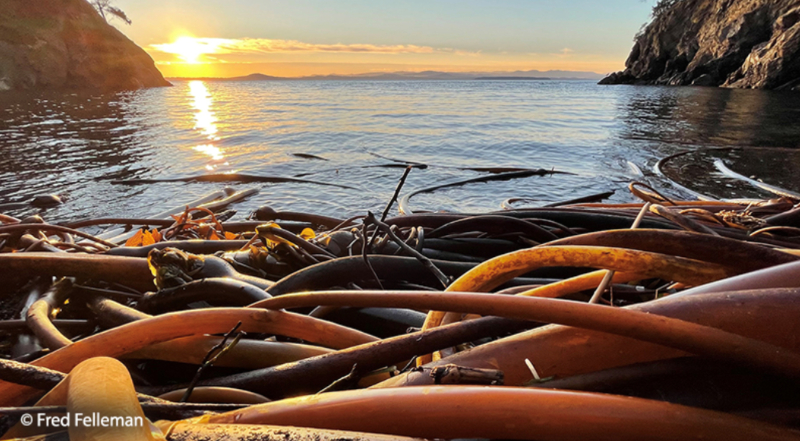
Bull kelp on the shores of San Juan Island
Washington state has a new state symbol. Last month, Gov. Bob Ferguson signed legislation making bull kelp Washington’s official state marine forest. To celebrate the news on Earth Day, I walked over to the Seattle Aquarium from my office to say hello to Nora Nickum, the aquarium’s vice president of conservation programs. We talked about why I believe bull kelp should be referred to as “charismatic megaflora” — just like awe-inspiring mammals like lions, elephants, and whales are sometimes called “charismatic megafauna.” Here’s a clip of our conversation.
Learn more about the Port’s partnership on kelp revitalization:
- Press release "Port of Seattle and Seattle Aquarium Collaborate to Restore Kelp Forests in Elliott Bay," April 26, 2022
- Video "The Port and Aquarium Partnership on Kelp," September 27, 2022
Photo at top: A Bigg’s (Transient) orca breaches in pursuit of a Dall’s Porpoise off the West side of San Juan Island (© Fred Felleman)
Subscribe to receive email updates from Commissioner Felleman

